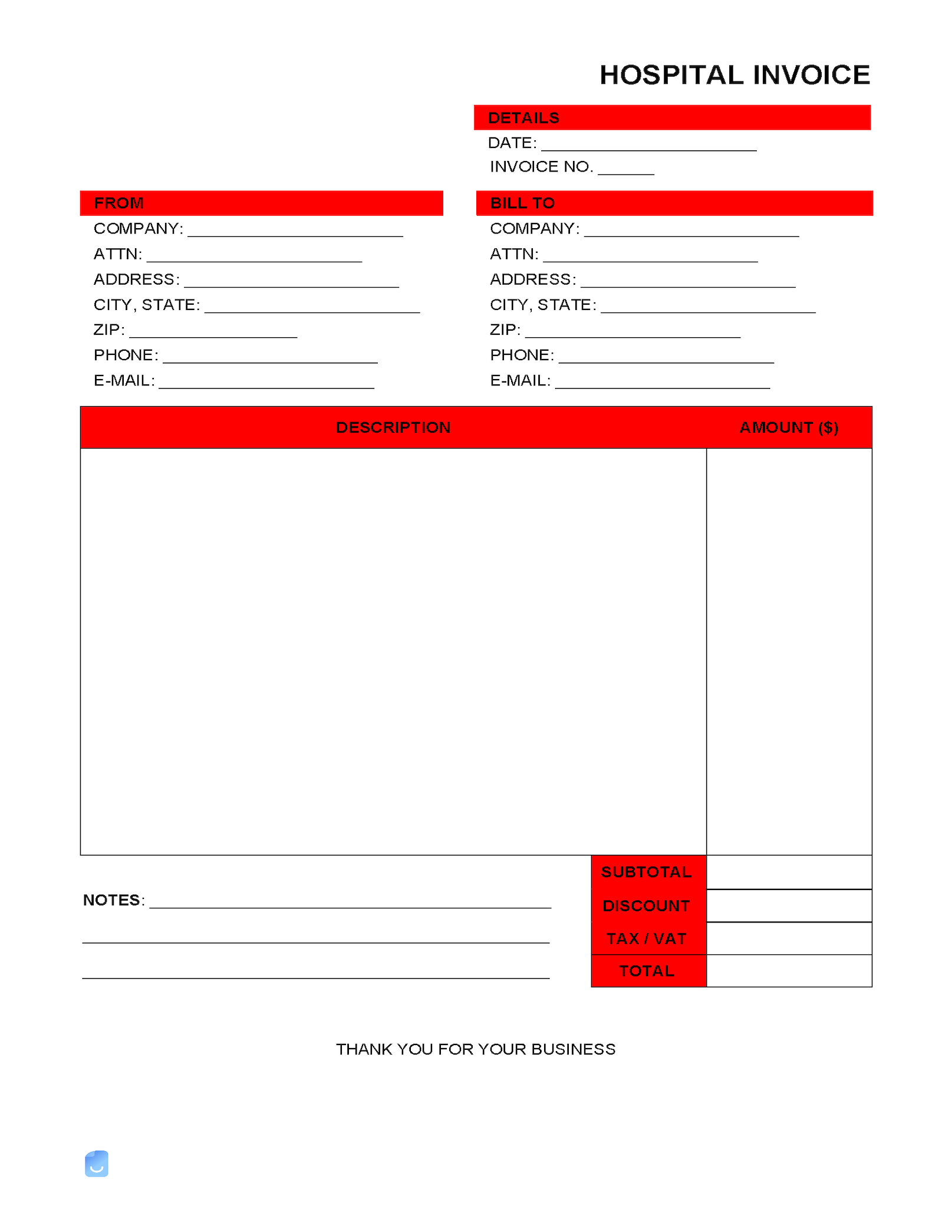Hospital Invoice Template
A hospital invoice is a document used to bill a patient after a stay at a hospital and lists the services provided, such as surgery or laboratory tests, as well as their itemized costs. Patients are notified of their outstanding balance via an invoice in order that they can contact their insurance company to arrange for coverage or partial coverage.
Hospital Billing
Hospital bills are often high. In addition to the cost of health care services, such as medicine, office visits, procedures, appointments, and tests, hospitals also charge for expenses related to accommodation, from room service to cleaning bedsheets. Billing rates generally consider the salaries of nurses and doctors. However, some hospital billing systems consider doctors’ services as separate from other services.
Hospital Billing Process
A hospital bill is calculated in the same way whether or not a patient has insurance coverage. Private insurance companies work with hospitals to determine how much of a hospital bill they are willing to cover. Each insurance company has different systems, plans, and requirements. It goes without saying that hospital billing can be complicated.
According to the American Hospital Association, hospitals deal with more than 1,600 insurance companies.
Making matters even more complex, the U.S. Congress sets hospital payment rates for Medicare patients, which make up about 41 percent of a typical hospital’s patients. For patients with Medicaid, state governments set rates. Hospital invoices are usually sent to a patient’s home address. In some cases, a hospital may send a patient a statement instead of an invoice. A statement is a summary of charges and is typically used when the patient has not yet paid the bill in full. When receiving an invoice, patients should contact their insurance provider and complete any required claim forms. If a hospital or doctor is outside a patient’s network, the insurer will generally refuse to pay for it.
Key Features of a Hospital Invoice
A hospital invoice typically includes the patient’s name, address, phone number, and account number, as well as a date and the date on which payment is due. Usually, the patient’s account number is located in the upper right-hand corner of the hospital invoice, just below the date. A typical hospital invoice will list the services rendered by the hospital and hospital staff and the cost of those services. The invoice is likely to include a breakdown of the charges, such as the cost of the room, the cost of the physician’s services, and the cost of laboratory tests. It will also likely list a co-pay fee, which is a fixed out-of-pocket amount paid by the patient for services covered by insurance. Co-pays can range widely. A hospital invoice will also reflect payment terms.
Average Hospital Bills
- 3-day hospital stay: $30,000
- Pregnancy/delivery: $14,800
- Back surgery: $25,000
- Appendix removal: $17,500
The cost of healthcare services depends on where you live, what insurance you have, and whether you negotiate your price. To get an idea of how wide the range of hospital-related services can be, a routine doctor’s visit may cost $50, while fixing a broken limb could cost $7,500. (Sources: HeathCare.gov, National Nurses United)
What Happens if You Don’t Pay Hospital Bills?
Hospitals have a revenue department that keeps track of patients’ payments and account balances. Professionals in this department make certain that all payments are made on time and work with third parties and health insurance companies to ensure invoices are paid. When a patient or insurer fails to pay a hospital bill, revenue departments of hospitals will partner with collection agencies to obtain payment. Once a bill has been sent to collections, a patient’s credit score will be affected. At that point, a patient will need to negotiate with the collection agency about the payment, which is likely to end up costing a good deal more than the original amount.
Hospitals Near Me
Every city and town has a hospital or a community hospital and if not a hospital, then an emergency care center. Use Google Maps to perform a search for the nearest hospital in your area. Check with your health insurance provider to see which hospitals in your area are in your insurance network.
